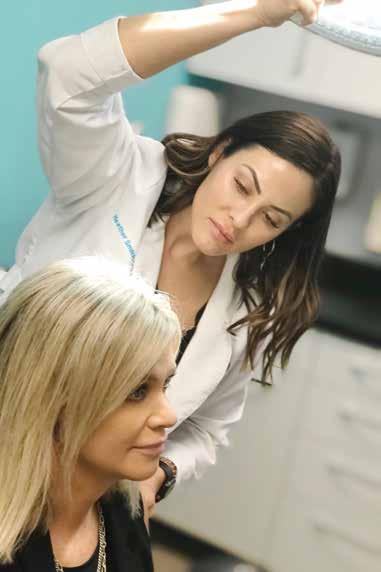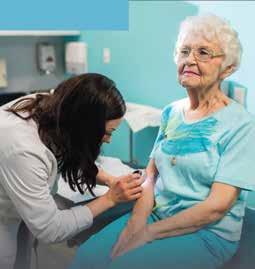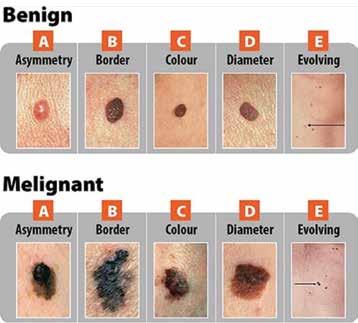
3 minute read
Protect your skin this Skin Cancer Awareness Month
By Abigail Blonigen
As the weather warms up and the sun finally begins to poke through the clouds, it is important to remember to take care of your skin.
May is Skin Cancer Awareness Month. According to the Skin Cancer Foundation, skin cancer is the most common form of cancer in the United States, with more than 9,500 people diagnosed with the disease every day.
Fortunately, it is also one of the most preventable forms of cancer, with the vast majority of cases being associated with exposure to ultraviolet radiation from the sun.
“People get scared when they hear the word skin cancer,” said dermatologist Susan Ash, M.D., at Essentia Health. “They think it’s a terrible diagnosis, when in fact most skin cancers are fairly easily treated and not going on to hurt them long term.”
Ash has been practicing dermatology for over 20 years. Most of her patients are at higher risk of developing skin cancer due to a history of sun exposure, having fair skin or a suppressed immune system due to a surgery.
“For me, it’s the challenge of can I find that skin cancer before it becomes a problem for them,” she said.
Heather Smith, MPAS, is a dermatology physician assistant and owner of Twin Ports Dermatology. She and her husband moved to Duluth and opened their practice over four years ago after realizing there was a shortage of dermatology practitioners in the area.
Twin Ports Dermatology focuses on preventative skin health, with skin cancer screenings being one of their primary services.

“I look head to toe, every square inch of their body,” Smith said. “It’s pretty in-depth, and we actually find things on people that they didn't even know they had because we’re catching it so early.”
Smith recommends that everyone over the age of 40 receive a full skin cancer screening once a year. Additionally, folks should check their own skin at least once a month to become familiar with their moles and note any changes or abnormalities.

Ash reminds her patients to be on the lookout for the ABCDE’s of melanoma in their moles: asymmetry, irregular borders, changing colors, a diameter bigger than a pencil eraser and if the growth is evolving.
Though melanoma tends to be discussed most since it is the most serious, there are several other types of skin cancer. The most common form is basal cell carcinoma, which typically looks like a pink spot on the skin or an acne lesion that refuses to heal. Basal cell carcinoma generally sits on the top layer of the skin and rarely spreads, so it is fairly easy to treat.
One in five people will develop a basal cell carcinoma by the age of 70, and one in 55 people will develop melanoma.
Squamous cell carcinoma is the second most common type of skin cancer, which usually looks like a pink, scaly spot on the skin. Like basal cell carcinoma, this form of cancer tends to stay on the top layer of skin and is usually easy to remove, however squamous cell carcinomas tend to be a bit more aggressive with a higher tendency to spread.
Early detection is key; the five-year survival rate for even melanoma is 99% when caught early.

In addition to self and professional skin screenings, there are a number of easy ways to minimize your risk of developing skin cancer.
Wear (a lot of) sunscreen. Smith recommends wearing a daily moisturizer with a sun protection factor of 30 or higher every day.
Those wanting to avoid chemicals in their sunscreen can opt for a mineral formula where elements like zinc and titanium dioxide sit on top of the skin to reflect the sun’s rays rather than being absorbed by the skin.
An SPF of 30 will block about 93% of the sun’s rays, whereas an SPF of 50 will block 95% to 97%. Even an SPF of 100 will not be perfect, so it’s important to also seek the shade and cover your skin with clothing.
Ash recommends applying sunscreen 20 minutes before going outside and reapplying sunscreen every two hours or immediately after sweating or swimming. Don’t be shy when slathering your skin, either; a shot glass full of product should be used for each application.
Respect the sun. Though getting outdoors is important for our physical and mental health, seek the shade and avoid direct sunlight.
“If you’re going to be doing outside activities, do it earlier in the morning or later in the afternoon,” Ash said. “Avoid that midday sun.”
Cover up. The more skin you can comfortably cover, the better. Smith recommends Ultraviolet Protectant Factor clothing, a wide brimmed hat and sunglasses when spending days outside.

Don’t go tanning. Just one indoor tanning session before the age of 35 increases your chances of developing melanoma by 75%.
“I know a lot of women in my age group who grew up in the ’80s, doing the tanning beds and the baby oil and abusing our skin. Those are the exact people that should be coming in and getting some basic skin checks to see what’s going on,” Smith said.
A common misconception is that a “base tan” can protect people from sunburn and skin damage, however, “the damage is actually the tan,” Ash said. “You don’t want to get burned, but the tan can be just as dangerous as the burn.”
Though skin cancer can be serious, proper prevention and early detection greatly reduce the risk of the disease becoming deadly. To schedule a skin cancer screening, reach out to your healthcare provider or dermatologist. D










